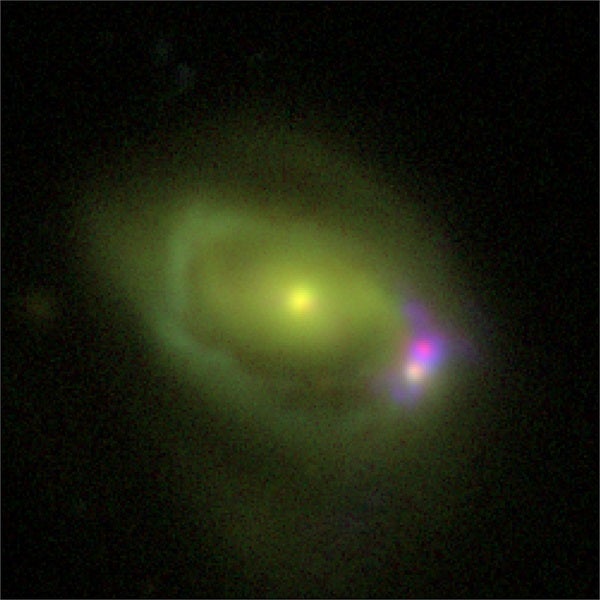Was 49 is a merging galaxy system that can actually be broken down into Was 49a, a larger disk-shaped galaxy, and Was 49b, a small dwarf galaxy. As these galaxies merge, the dwarf Was 49b can be seen rotating within the larger disk of Was 49a, currently about 26,000 light-years from the center of the disk. Using NASA’s Nuclear Spectroscopic Telescope Array (NuSTAR), the Sloan Digital Sky Survey (SDSS), the Chandra X-ray Observatory, and the Swift mission, a team led by postdoctoral fellow Nathan Secrest at the U.S. Naval Research Laboratory in Washington has determined that Was 49b is extremely bright in high-energy X-rays. And such high-energy X-ray luminosity is the fingerprint of emission from a supermassive black hole — one that’s larger than astronomers expect a dwarf galaxy to harbor.
“This is a completely unique system and runs contrary to what we understand of galaxy mergers,” Secrest said in a press release announcing the discovery. The results were recently published in February in the Astrophysical Journal. “We didn’t think that dwarf galaxies hosted supermassive black holes this big. This black hole could be hundreds of times more massive than what we would expect for a galaxy of this size, depending on how the galaxy evolved in relation to other galaxies.”
Current estimates place Was 49b’s supermassive black hole at more than 2 percent of the dwarf galaxy’s entire mass. That may sound like a small fraction, but it’s monstrous when compared with the supermassive black holes hosted in other dwarf galaxies of similar masses. What’s more, Was 49b’s black hole is active — as an active galactic nucleus, or AGN, it’s currently feeding on large amounts of gas and dust, spewing out massive amounts of radiation as it does so. Like many other AGN, Was 49b’s nucleus is shrouded in a “torus,” or donut-shaped cloud of obscuring material.
In the current picture of galaxy mergers, as galaxies merge, so too do their central supermassive black holes. This process often funnels dust and gas into the centers of the galaxies, turning their nuclei “on” as AGN. But what’s strange about this particular merger is the fact that the smaller galaxy, which should be easily gobbled by the larger one, hosts the more active supermassive black hole. By comparison, the larger disk galaxy Was 49 has a relatively quiescent AGN, and that’s the complete opposite of what astronomers expect. Normally, the material disturbed during a galaxy merger should funnel into the larger galaxy’s black hole, making it the more luminous AGN.
So what’s going on here? Astronomers are searching for the answer, but there are a few possibilities. Was 49b may have simply hosted an uncharacteristically large supermassive black hole for the galaxy’s size, long before it was pulled in by the gravity of Was 49a. Alternatively, Was 49b’s black hole may have grown dramatically during the earliest stages of the merger due to the motions of gas and dust during the process. Whatever the answer, Secrest said, “This study is important because it may give new insight into how supermassive black holes form and grow in such systems.” That includes the creation and growth of the Milky Way’s central supermassive black hole.
As the merger progresses, the two supermassive black holes will also merge – but that event won’t occur for a few hundred million years, yet.










